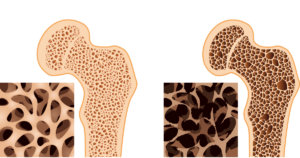Osteoporosis
 Osteoporosis affects an estimated 75 million people in the USA, Europe, and Japan, with 1 in 3 women and 1 in 5 men over the age of 50 experiencing osteoporotic fractures. It is a disease of aging (see post on aging. It is more common in women. Other factors that increase risk include: Family history of osteoporosis, Menopause and hysterectomy, Long-term glucocorticoid therapy (pregnisone), and Rheumatoid arthritis •
Osteoporosis affects an estimated 75 million people in the USA, Europe, and Japan, with 1 in 3 women and 1 in 5 men over the age of 50 experiencing osteoporotic fractures. It is a disease of aging (see post on aging. It is more common in women. Other factors that increase risk include: Family history of osteoporosis, Menopause and hysterectomy, Long-term glucocorticoid therapy (pregnisone), and Rheumatoid arthritis •
Bone tissue is largely collagen protein that is mineralized with hexagonal crystals of hydroxyapatite (calcium and phosphorus). This combination gives bone its strength. When collagen and hydroxyapatite are lost the bone becomes fragile.
DXA scan – is a diagnostic low dose x-ray that measures the amount of minerals in the bone (which block the x-rays. A T-score of −2.5 or lower indicates osteoporosis. Osteopenia is the less severe loss of bone density and is usually a precursor to osteoporosis.
Lifestyle factors that can contribute to osteoporosis.
- Alcohol – reduce alcohol consumption.
- Smoking – stop smoking.
- Low body mass index and Poor nutrition, low mineral intake, and Eating disorders – Support maintenance of a healthy body weight, improve diet and supplement nutrients.
- Low omega 3 fatty acids in diet – This can increase inflammation which increases bone loss.
- Insufficient exercise – Add weight-bearing exercise, consider whole body vibration therapy.
Therapeutic Diet and Nutritional Considerations
- Vitamin D is needed by bone. Without supplementation or intense sun most people are deficient. Support optimal vitamin D status through D3 supplements and safe sun exposure.
- Vitamin K2 is a bone protective vitamin
- Tocotrienols are a form of vitamin E that has been shown to be particularly effective and decreasing bone loss.
- GG (geranylgeraniol) – A unique substance that can support protein metabolism in aging and aging related diseases.
- Omega 3 fatty acids (EPA and DHA) modulate inflammation – see post on Inflammation.
- Protein: Adequate protein is needed to produce collagen and support bone health (Beef, bison, chicken, turkey, lamb, fish, shellfish, beans, legumes, nuts, seeds).
- Estrogen and Isoflavones (phytoestrogens – from plants) can support bone metabolism (eg. Genistin and Ipriflavone).
- Minerals
- Calcium – Is the main mineral of bone. Take 1,000 mg to 1,300 mg daily (Yogurt, sardines, cheese, salmon, turnip greens, kale).
- Magnesium – Magnesium is needed to properly use calcium. It is a common deficiency. Take 310 mg to 420 mg daily (Kale, spinach, Swiss chard, pumpkin seeds, almonds, cashews, black beans, dark chocolate).
- Trace Minerals – such as boron and silicon help bone metabolism.
Supplement Protocol
Below are a few specific supplements that can achieve these goals. Specific dosing, additional information and ordering information (and a discount on all orders) can be found at my FullScript Dispensory. Just create your account by clicking below. Then go to Recommendations – Protocols – Osteoporosis.
Dr. Michels FullScript Dispensory – us.fullscript.com/welcome/JordanMichels
Osteoben® from Designs for Health – is formulated to address the pathophysiology of osteopenia and osteoporosis, providing patients with the proper bone-supportive nutritional requirements. Besides calcium, Magnesium and other minerals osteoben contains the isoflavone genistein (a phytoestrogen), which works to target the decreased BMD (bone mineral density) seen in osteopenia and osteoporosis.
Collagen Peptides from Vital Proteins’- are sourced from grass-fed, pasture-raised bovine hides to ensure a high-quality source of this ancient nutrient. Collagen is the most abundant protein in the body supporting the health and vitality of your skin, hair, nails, bones, and joints.* These peptides are easily digestible and soluble in cold or hot liquids.
K2 MK-7 and D3 – from Protocol for Life Balance – Research indicates that a synergistic relationship exists between vitamin K2 and vitamin D3, especially in terms of bone strength and cardiovascular health.* While vitamin D3 is recognized for its role in calcium absorption and metabolism, it is vitamin K2 that directs calcium to bones rather than joint spaces and arteries.* This product is formulated with a clinically relevant dose of MK-7 (5000 iu D3 and 180 mcg. K2)
Annatto-E™ GG – from Designs for Health- is a combination of two ingredients: 150 mg of annatto tocotrienols, a unique tocopherol-free, tocotrienols-only product, featuring tocotrienols sourced from the annatto tree; and 150 mg of geranylgeraniol (GG), a compound that plays critical roles in numerous biological processes affecting organs and tissues throughout the body.
OmegAvail™ Hi-Po – from Designs for Health – provides a potent 1600 mg of EPA/DHA per serving (two softgels).
Trace Minerals – from Pure Encapsulations – is a blend of essential minerals to support nutrient metabolism and cellular function throughout the body.